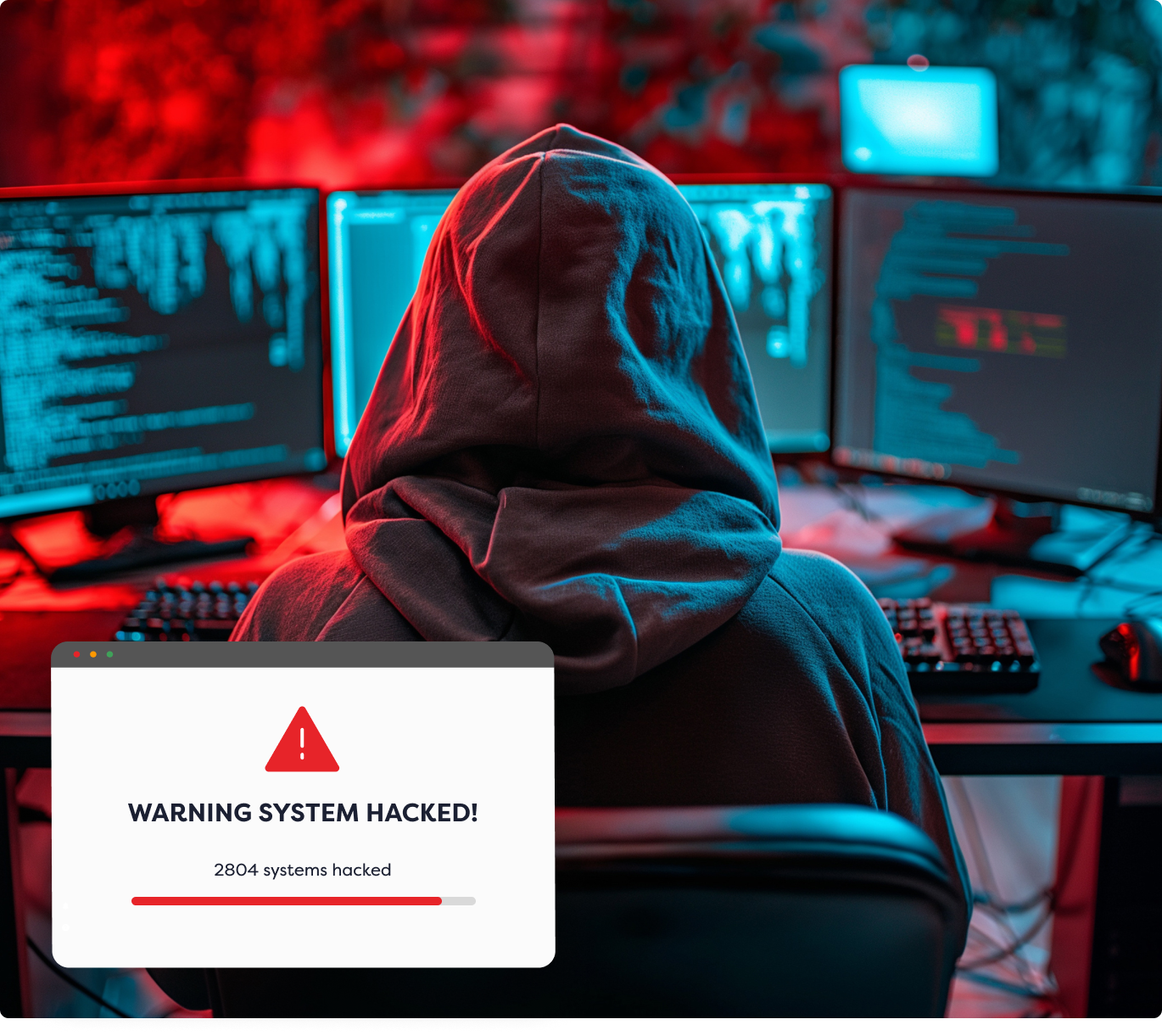The importance of external penetration testing

Join 1,000+ leading companies who trust Rootshell Security
What is external penetration testing?
This test primarily targets an organization’s perimeter systems. It focuses on external-facing assets such as public-facing websites, internet-accessible hosts, and web applications. If you can identify any security weaknesses and Potential Threats in these assets, you can improve your cyber defenses.
Cyber Attack Simulations also help your business identify the potential impact of a successful breach. This approach provides actionable feedback and remediation advice for enhancing overall security.
How external penetration testing compares to internal pen testing and vulnerability scanning
External penetration testing
- Focuses on your business’s external-facing assets, such as public websites, external network services, and internet-facing applications.
- Identifies and rectifies vulnerabilities that could be exploited by attackers from outside the organization.
- Demonstrates how an attacker would attempt to access sensitive data through the internet.
- Prevents breaches from outside, ensuring vulnerabilities are identified and mitigated from an outside-in perspective.
- In-depth, manual process.
- Experienced testers actively identify and exploit vulnerabilities in external-facing assets like websites and network services.
- Mimics an attacker’s actions to understand the actual damage they could cause.
- Shows how far an attacker could get into the system.
- Checks the organization’s ability to detect and respond to the attack.
- Typically conducted sporadically for a detailed, realistic assessment of defenses against deliberate attacks.
Internal penetration testing
- Targets your internal network, assuming an attacker has gained access or that an insider threat exists.
- Evaluates the security from the inside, checking the potential damage a compromised system could cause.
- Assesses how far an attacker could move laterally within the network.
- Evaluates internal security controls and the ability to detect and respond to insider threats or breaches.
- Identifies and addresses risks leading to data loss or operational disruption.
- Ensures vulnerabilities are mitigated from an inside-out perspective.
Vulnerability scanning
- Automated process.
- Identifies potential vulnerabilities in networks, systems, or applications using software tools.
- Scans for known security weaknesses and generates a list of issues needing attention.
- Faster and less resource-intensive compared to penetration testing.
- Provides a broad overview of the organization’s security posture.
- Can be conducted frequently to provide quick insights.
- Only identifies potential vulnerabilities, not exploits them.
Features of external penetration testing
External penetration testing employs a systematic approach to imitate attacks, revealing potential weaknesses in network defenses and external applications. Here’s a closer look at the distinct features that make this type of testing indispensable:
Real-world attack simulation
This copies real-world attack scenarios that an attacker could use to gain unauthorized access from outside the organization. This helps identify weak points in network defenses and external applications.
Comprehensive vulnerability assessment
Testers use a variety of tools and techniques to scan for vulnerabilities in public IPs and domain names. They test for common vulnerabilities such as SQL injection, cross-site scripting, and buffer overflows, which are typical entry points for hackers.
Remote testing
Unlike internal testing, external tests are performed remotely, mimicking the actions of an actual attacker trying to infiltrate the organization’s systems from outside the network perimeter.
Detailed reporting
After testing, you get a detailed report which outlines discovered vulnerabilities, the severity of each issue, and recommendations for remediation to help you prioritize security enhancements.
Minimized disruption
Care is taken to ensure that testing does not disrupt normal business operations or cause downtime, making it a non-intrusive yet effective method to strengthen external security defenses.

External penetration testing methodology and process
The process of external penetration testing is meticulously planned and follows a systematic approach. While there may be some variations in specific steps, a typical penetration test often includes the following stages:
Reconnaissance
This is the initial phase where the penetration tester, or pentester, gathers as much information as possible about the target network and systems. It could involve methods like port scans or checking public databases for any known vulnerabilities.
Scanning
Here, the pentester uses penetration testing tools like Nmap, Wireshark, Nessus, and Burp Suite to establish a detailed understanding of the organization’s system. These tools perform different tasks such as mapping out the network, identifying live hosts, or checking for open ports and services.
Exploiting
This is the stage where the actual attacking begins. The pentester uses the information collected in the scanning phase to exploit vulnerabilities using such tools as Metasploit. They attempt to gain access to the target system or network, mimicking the actions of a malicious attacker.
Post-exploitation
After gaining the required access, the penetration tester explores the network to find out what kind of valuable data or resources they can access and to what extent, simulating what a real attacker might do once they’ve breached the system.
Reporting
In this concluding stage, the pentester provides a comprehensive report, detailing their findings, including the weaknesses identified, data that could be accessed, and necessary remediation advice.
Hear why the world’s top companies trust us for external penetrating testing

Boost your cybersecurity with penetration testing
Benefits of external penetration testing
External penetration testing offers numerous tangible benefits to your business, shaping a sturdy foundation for your cybersecurity framework.
Identify vulnerabilities
Mitigate risks
Comply with regulations
Save money
Manage vendors
External penetration testing check list
A checklist for external penetration testing is crucial for thoroughly evaluating an organization’s cybersecurity defenses, ensuring effective preparation, execution, and follow-up.
- Define scope: Identify which systems, networks, and applications will be tested.
- Gather intelligence: Collect data about the target environment to plan the attack vectors.
- Testing tools preparation: Choose appropriate tools and techniques based on the scope and intelligence gathered.
- Conduct testing: Execute the penetration test, documenting all steps and findings.
- Analyze findings: Assess the vulnerabilities exploited and the data accessed.
- Report and remediate: Provide detailed findings and recommend security enhancements.
- Review and retest: Verify that security improvements have been implemented effectively.
Recognized industry leader in penetration testing as a service (PTaaS)
Selecting the best provider for external penetration testing
01
Define requirements
02
Evaluate expertise
03
Understand approach
04
Consider compliance
05
Support
06
Cost and value
07
Reputation & reviews
08
Trial engagement
If possible, start with a smaller pilot project to evaluate their capabilities and work style before committing to a larger engagement.
Frequently asked questions & answers
Can’t find the answer to your question?
You can always Contact Our Team of experts for a chat!
How long does an external pen test take?
The duration of an external network penetration test can vary significantly depending on several factors. Typically, a basic external pen test ranges from a few days to a couple of weeks. Factors that influence the timeframe include the complexity and size of the network, the depth of the test required, and the specific goals set by the organization.
For smaller networks with limited scopes, a test can be completed relatively quickly. In contrast, larger networks with more comprehensive testing requirements may require a more extended period to thoroughly examine all potential vulnerabilities. Additionally, the testing process can be extended if the security testing uncovers significant security issues that need deeper investigation.
You should also account for the time needed after testing to review the findings, implement remediation measures, and potentially retest the system to ensure all vulnerabilities have been adequately addressed.
What are the types of external penetration tests?
Black-Box Testing
This replicates an attack from a hacker with no prior knowledge of the system’s architecture. The testers do not have access to any internal information of the targeted systems, much like a real external attacker.
White-Box Testing
Assumes the attack is being carried out by someone with extensive knowledge of the system. The penetration tester has complete access to a comprehensive blueprint of the organization’s network infrastructure, source codes, IPs, and even the algorithms in use.
Gray-box testing
This is a blend of both black and white-box testing. The tester has partial access to the system’s internals, often mimicking the threat level of an external party that has gained significant, but not complete, system information.
These various methodologies are formulated to offer your organization a holistic understanding of your systems’ vulnerabilities. By selecting the most suitable method, you can focus on detailed areas of concern, improving security measures to safeguard against both known and unknown cyber threats and protect valuable data.
Why choose Rootshell for external penetration testing services?
External penetration testing is an investment that your business must make to protect against ever-evolving cyber threats. It removes any guesswork from your defense strategy, so your cybersecurity is as airtight as it can be.
With Rootshell’s White Label penetration testing platform, you get the assurance that your business’s security is in the right hands. We have a strong team of cybersecurity experts who use the power of AI to give you better results.
Our penetration testing services encompass both internal and external pentesting to give you the complete picture of your defense landscape.


